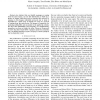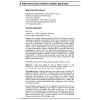507 search results - page 58 / 102 » Attacking DDoS at the Source |
CSFW
2010
IEEE
15 years 1 months ago
2010
IEEE
—An attacker that can identify messages as coming from the same source, can use this information to build up a picture of targets’ behaviour, and so, threaten their privacy. In...
NETWORK
2008
14 years 9 months ago
2008
The Domain Name System (DNS) is the global lookup service for network resources. To protect DNS information, the DNS Security Extensions (DNSSEC) have been developed and deployed ...
116
click to vote
IJCCBS
2010
14 years 8 months ago
2010
: True random number generators (TRNGs) are extensively used in cryptography, simulations and statistics. In this work, we introduce, extend and analyse the concept of the randomis...
ISW
2010
Springer
14 years 7 months ago
2010
Springer
Abstract. Instruction Set Randomization (ISR) is a promising technique for preventing code-injection attacks. In this paper we present a complete randomization framework for JavaSc...
IPCCC
2006
IEEE
15 years 3 months ago
2006
IEEE
In recent years, malicious software (malware) has become one of the most insidious threats in computer security. However, this is arguably not the result of increased sophisticati...


